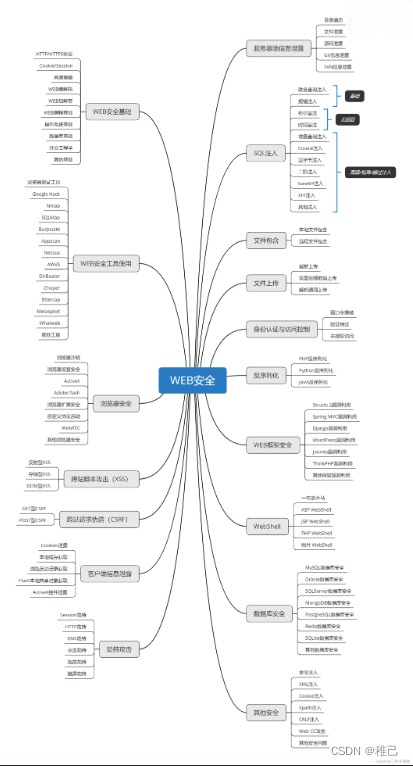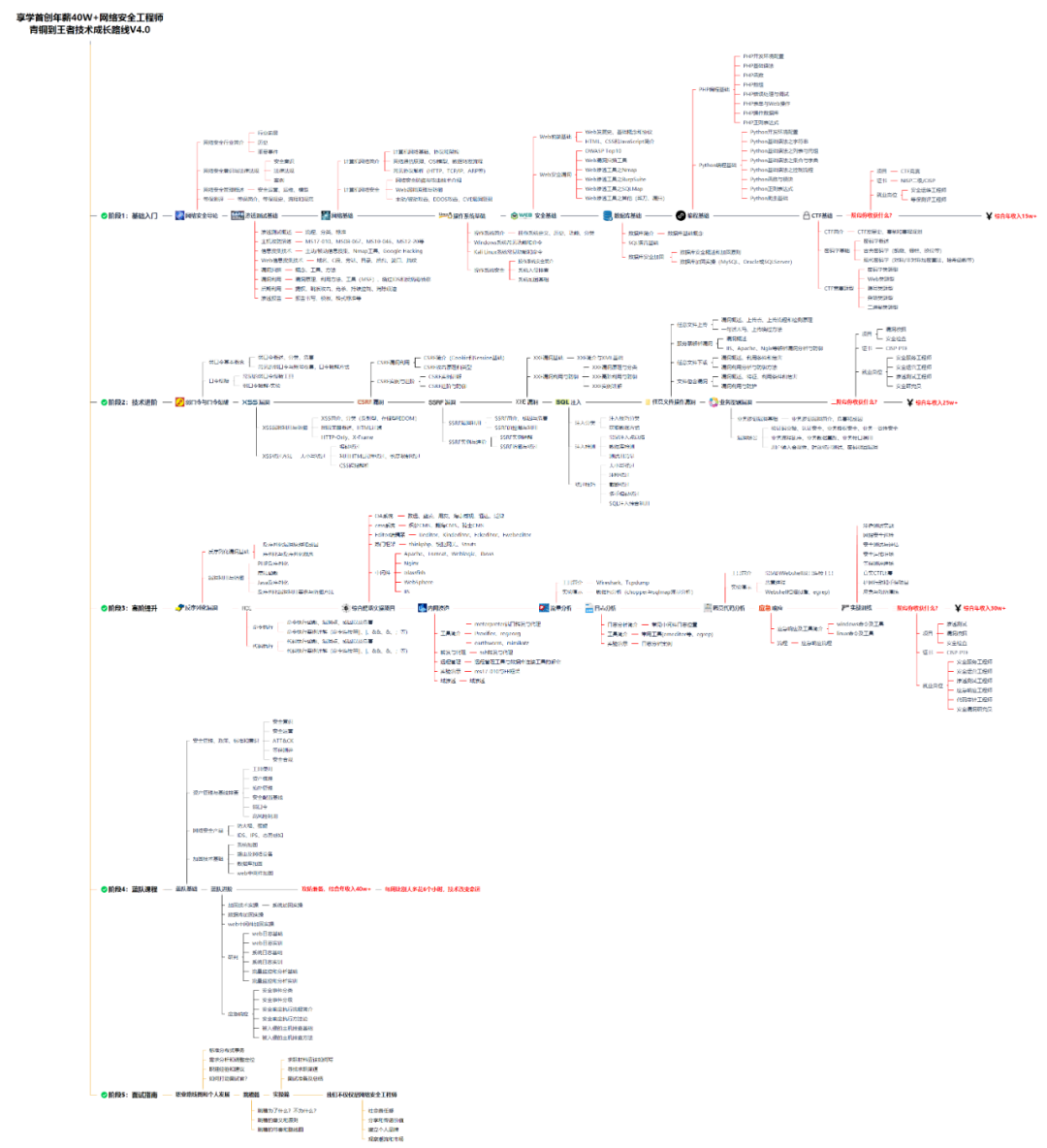学习路线:
这个方向初期比较容易入门一些,掌握一些基本技术,拿起各种现成的工具就可以开黑了。不过,要想从脚本小子变成黑客大神,这个方向越往后,需要学习和掌握的东西就会越来越多以下是网络渗透需要学习的内容:

网上学习资料一大堆,但如果学到的知识不成体系,遇到问题时只是浅尝辄止,不再深入研究,那么很难做到真正的技术提升。
一个人可以走的很快,但一群人才能走的更远!不论你是正从事IT行业的老鸟或是对IT行业感兴趣的新人,都欢迎加入我们的的圈子(技术交流、学习资源、职场吐槽、大厂内推、面试辅导),让我们一起学习成长!
- 参数 key: 密钥的字符串数组。
/
void deAes(char c, int clen, char* key);
#endif
#### aes.cpp
#include <stdio.h>
#include <stdlib.h>
#include <string.h>
#include “aes.h”
/**
- S盒
*/
static const int S[16][16] = { 0x63, 0x7c, 0x77, 0x7b, 0xf2, 0x6b, 0x6f, 0xc5, 0x30, 0x01, 0x67, 0x2b, 0xfe, 0xd7, 0xab, 0x76,
0xca, 0x82, 0xc9, 0x7d, 0xfa, 0x59, 0x47, 0xf0, 0xad, 0xd4, 0xa2, 0xaf, 0x9c, 0xa4, 0x72, 0xc0,
0xb7, 0xfd, 0x93, 0x26, 0x36, 0x3f, 0xf7, 0xcc, 0x34, 0xa5, 0xe5, 0xf1, 0x71, 0xd8, 0x31, 0x15,
0x04, 0xc7, 0x23, 0xc3, 0x18, 0x96, 0x05, 0x9a, 0x07, 0x12, 0x80, 0xe2, 0xeb, 0x27, 0xb2, 0x75,
0x09, 0x83, 0x2c, 0x1a, 0x1b, 0x6e, 0x5a, 0xa0, 0x52, 0x3b, 0xd6, 0xb3, 0x29, 0xe3, 0x2f, 0x84,
0x53, 0xd1, 0x00, 0xed, 0x20, 0xfc, 0xb1, 0x5b, 0x6a, 0xcb, 0xbe, 0x39, 0x4a, 0x4c, 0x58, 0xcf,
0xd0, 0xef, 0xaa, 0xfb, 0x43, 0x4d, 0x33, 0x85, 0x45, 0xf9, 0x02, 0x7f, 0x50, 0x3c, 0x9f, 0xa8,
0x51, 0xa3, 0x40, 0x8f, 0x92, 0x9d, 0x38, 0xf5, 0xbc, 0xb6, 0xda, 0x21, 0x10, 0xff, 0xf3, 0xd2,
0xcd, 0x0c, 0x13, 0xec, 0x5f, 0x97, 0x44, 0x17, 0xc4, 0xa7, 0x7e, 0x3d, 0x64, 0x5d, 0x19, 0x73,
0x60, 0x81, 0x4f, 0xdc, 0x22, 0x2a, 0x90, 0x88, 0x46, 0xee, 0xb8, 0x14, 0xde, 0x5e, 0x0b, 0xdb,
0xe0, 0x32, 0x3a, 0x0a, 0x49, 0x06, 0x24, 0x5c, 0xc2, 0xd3, 0xac, 0x62, 0x91, 0x95, 0xe4, 0x79,
0xe7, 0xc8, 0x37, 0x6d, 0x8d, 0xd5, 0x4e, 0xa9, 0x6c, 0x56, 0xf4, 0xea, 0x65, 0x7a, 0xae, 0x08,
0xba, 0x78, 0x25, 0x2e, 0x1c, 0xa6, 0xb4, 0xc6, 0xe8, 0xdd, 0x74, 0x1f, 0x4b, 0xbd, 0x8b, 0x8a,
0x70, 0x3e, 0xb5, 0x66, 0x48, 0x03, 0xf6, 0x0e, 0x61, 0x35, 0x57, 0xb9, 0x86, 0xc1, 0x1d, 0x9e,
0xe1, 0xf8, 0x98, 0x11, 0x69, 0xd9, 0x8e, 0x94, 0x9b, 0x1e, 0x87, 0xe9, 0xce, 0x55, 0x28, 0xdf,
0x8c, 0xa1, 0x89, 0x0d, 0xbf, 0xe6, 0x42, 0x68, 0x41, 0x99, 0x2d, 0x0f, 0xb0, 0x54, 0xbb, 0x16 };
/**
- 逆S盒
*/
static const int S2[16][16] = { 0x52, 0x09, 0x6a, 0xd5, 0x30, 0x36, 0xa5, 0x38, 0xbf, 0x40, 0xa3, 0x9e, 0x81, 0xf3, 0xd7, 0xfb,
0x7c, 0xe3, 0x39, 0x82, 0x9b, 0x2f, 0xff, 0x87, 0x34, 0x8e, 0x43, 0x44, 0xc4, 0xde, 0xe9, 0xcb,
0x54, 0x7b, 0x94, 0x32, 0xa6, 0xc2, 0x23, 0x3d, 0xee, 0x4c, 0x95, 0x0b, 0x42, 0xfa, 0xc3, 0x4e,
0x08, 0x2e, 0xa1, 0x66, 0x28, 0xd9, 0x24, 0xb2, 0x76, 0x5b, 0xa2, 0x49, 0x6d, 0x8b, 0xd1, 0x25,
0x72, 0xf8, 0xf6, 0x64, 0x86, 0x68, 0x98, 0x16, 0xd4, 0xa4, 0x5c, 0xcc, 0x5d, 0x65, 0xb6, 0x92,
0x6c, 0x70, 0x48, 0x50, 0xfd, 0xed, 0xb9, 0xda, 0x5e, 0x15, 0x46, 0x57, 0xa7, 0x8d, 0x9d, 0x84,
0x90, 0xd8, 0xab, 0x00, 0x8c, 0xbc, 0xd3, 0x0a, 0xf7, 0xe4, 0x58, 0x05, 0xb8, 0xb3, 0x45, 0x06,
0xd0, 0x2c, 0x1e, 0x8f, 0xca, 0x3f, 0x0f, 0x02, 0xc1, 0xaf, 0xbd, 0x03, 0x01, 0x13, 0x8a, 0x6b,
0x3a, 0x91, 0x11, 0x41, 0x4f, 0x67, 0xdc, 0xea, 0x97, 0xf2, 0xcf, 0xce, 0xf0, 0xb4, 0xe6, 0x73,
0x96, 0xac, 0x74, 0x22, 0xe7, 0xad, 0x35, 0x85, 0xe2, 0xf9, 0x37, 0xe8, 0x1c, 0x75, 0xdf, 0x6e,
0x47, 0xf1, 0x1a, 0x71, 0x1d, 0x29, 0xc5, 0x89, 0x6f, 0xb7, 0x62, 0x0e, 0xaa, 0x18, 0xbe, 0x1b,
0xfc, 0x56, 0x3e, 0x4b, 0xc6, 0xd2, 0x79, 0x20, 0x9a, 0xdb, 0xc0, 0xfe, 0x78, 0xcd, 0x5a, 0xf4,
0x1f, 0xdd, 0xa8, 0x33, 0x88, 0x07, 0xc7, 0x31, 0xb1, 0x12, 0x10, 0x59, 0x27, 0x80, 0xec, 0x5f,
0x60, 0x51, 0x7f, 0xa9, 0x19, 0xb5, 0x4a, 0x0d, 0x2d, 0xe5, 0x7a, 0x9f, 0x93, 0xc9, 0x9c, 0xef,
0xa0, 0xe0, 0x3b, 0x4d, 0xae, 0x2a, 0xf5, 0xb0, 0xc8, 0xeb, 0xbb, 0x3c, 0x83, 0x53, 0x99, 0x61,
0x17, 0x2b, 0x04, 0x7e, 0xba, 0x77, 0xd6, 0x26, 0xe1, 0x69, 0x14, 0x63, 0x55, 0x21, 0x0c, 0x7d };
/**
- 获取整形数据的低8位的左4个位
*/
static int getLeft4Bit(int num) {
int left = num & 0x000000f0;
return left >> 4;
}
/**
- 获取整形数据的低8位的右4个位
/
static int getRight4Bit(int num) {
return num & 0x0000000f;
}
/* - 根据索引,从S盒中获得元素
*/
static int getNumFromSBox(int index) {
int row = getLeft4Bit(index);
int col = getRight4Bit(index);
return S[row][col];
}
/**
- 把一个字符转变成整型
*/
static int getIntFromChar(char c) {
int result = (int)c;
return result & 0x000000ff;
}
/**
- 把16个字符转变成4X4的数组,
- 该矩阵中字节的排列顺序为从上到下,
- 从左到右依次排列。
/
static void convertToIntArray(char str, int pa[4][4]) {
int k = 0;
int i, j;
for (i = 0; i < 4; i++)
for (j = 0; j < 4; j++) {
pa[j][i] = getIntFromChar(str[k]);
k++;
}
}
/**
- 打印4X4的数组
*/
static void printArray(int a[4][4]) {
int i, j;
for (i = 0; i < 4; i++) {
for (j = 0; j < 4; j++)
printf(“a[%d][%d] = 0x%x “, i, j, a[i][j]);
printf(”\n”);
}
printf(“\n”);
}
/**
- 打印字符串的ASSCI,
- 以十六进制显示。
/
static void printASSCI(char str, int len) {
int i;
for (i = 0; i < len; i++)
printf(“0x%x “, getIntFromChar(str[i]));
printf(”\n”);
}
/**
- 把连续的4个字符合并成一个4字节的整型
/
static int getWordFromStr(char str) {
int one, two, three, four;
one = getIntFromChar(str[0]);
one = one << 24;
two = getIntFromChar(str[1]);
two = two << 16;
three = getIntFromChar(str[2]);
three = three << 8;
four = getIntFromChar(str[3]);
return one | two | three | four;
}
/**
- 把一个4字节的数的第一、二、三、四个字节取出,
- 入进一个4个元素的整型数组里面。
*/
static void splitIntToArray(int num, int array[4]) {
int one, two, three;
one = num >> 24;
array[0] = one & 0x000000ff;
two = num >> 16;
array[1] = two & 0x000000ff;
three = num >> 8;
array[2] = three & 0x000000ff;
array[3] = num & 0x000000ff;
}
/**
-
将数组中的元素循环左移step位
*/
static void leftLoop4int(int array[4], int step) {
int temp[4];
int i;
int index;
for (i = 0; i < 4; i++)
temp[i] = array[i];index = step % 4 == 0 ? 0 : step % 4;
for (i = 0; i < 4; i++) {
array[i] = temp[index];
index++;
index = index % 4;
}
}
/**
- 把数组中的第一、二、三和四元素分别作为
- 4字节整型的第一、二、三和四字节,合并成一个4字节整型
*/
static int mergeArrayToInt(int array[4]) {
int one = array[0] << 24;
int two = array[1] << 16;
int three = array[2] << 8;
int four = array[3];
return one | two | three | four;
}
/**
-
常量轮值表
/
static const int Rcon[10] = { 0x01000000, 0x02000000,
0x04000000, 0x08000000,
0x10000000, 0x20000000,
0x40000000, 0x80000000,
0x1b000000, 0x36000000 };
/* -
密钥扩展中的T函数
*/
static int T(int num, int round) {
int numArray[4];
int i;
int result;
splitIntToArray(num, numArray);
leftLoop4int(numArray, 1);//字循环//字节代换
for (i = 0; i < 4; i++)
numArray[i] = getNumFromSBox(numArray[i]);result = mergeArrayToInt(numArray);
return result ^ Rcon[round];
}
//密钥对应的扩展数组
static int w[44];
/**
- 打印W数组
*/
static void printW() {
int i, j;
for (i = 0, j = 1; i < 44; i++, j++) {
printf(“w[%d] = 0x%x “, i, w[i]);
if (j % 4 == 0)
printf(”\n”);
}
printf(“\n”);
}
/**
-
扩展密钥,结果是把w[44]中的每个元素初始化
/
static void extendKey(char key) {
int i, j;
for (i = 0; i < 4; i++)
w[i] = getWordFromStr(key + i * 4);for (i = 4, j = 0; i < 44; i++) {
if (i % 4 == 0) {
w[i] = w[i - 4] ^ T(w[i - 1], j);
j++;//下一轮
}
else {
w[i] = w[i - 4] ^ w[i - 1];
}
}
}
/**
-
轮密钥加
*/
static void addRoundKey(int array[4][4], int round) {
int warray[4];
int i, j;
for (i = 0; i < 4; i++) {splitIntToArray(w[round * 4 + i], warray); for (j = 0; j < 4; j++) { array[j][i] = array[j][i] ^ warray[j]; }}
}
/**
- 字节代换
*/
static void subBytes(int array[4][4]) {
int i, j;
for (i = 0; i < 4; i++)
for (j = 0; j < 4; j++)
array[i][j] = getNumFromSBox(array[i][j]);
}
/**
-
行移位
*/
static void shiftRows(int array[4][4]) {
int rowTwo[4], rowThree[4], rowFour[4];
int i;
for (i = 0; i < 4; i++) {
rowTwo[i] = array[1][i];
rowThree[i] = array[2][i];
rowFour[i] = array[3][i];
}leftLoop4int(rowTwo, 1);
leftLoop4int(rowThree, 2);
leftLoop4int(rowFour, 3);for (i = 0; i < 4; i++) {
array[1][i] = rowTwo[i];
array[2][i] = rowThree[i];
array[3][i] = rowFour[i];
}
}
/**
- 列混合要用到的矩阵
*/
static const int colM[4][4] = { 2, 3, 1, 1,
1, 2, 3, 1,
1, 1, 2, 3,
3, 1, 1, 2 };
static int GFMul2(int s) {
int result = s << 1;
int a7 = result & 0x00000100;
if (a7 != 0) {
result = result & 0x000000ff;
result = result ^ 0x1b;
}
return result;
}
static int GFMul3(int s) {
return GFMul2(s) ^ s;
}
static int GFMul4(int s) {
return GFMul2(GFMul2(s));
}
static int GFMul8(int s) {
return GFMul2(GFMul4(s));
}
static int GFMul9(int s) {
return GFMul8(s) ^ s;
}
static int GFMul11(int s) {
return GFMul9(s) ^ GFMul2(s);
}
static int GFMul12(int s) {
return GFMul8(s) ^ GFMul4(s);
}
static int GFMul13(int s) {
return GFMul12(s) ^ s;
}
static int GFMul14(int s) {
return GFMul12(s) ^ GFMul2(s);
}
/**
-
GF上的二元运算
*/
static int GFMul(int n, int s) {
int result;if (n == 1)
result = s;
else if (n == 2)
result = GFMul2(s);
else if (n == 3)
result = GFMul3(s);
else if (n == 0x9)
result = GFMul9(s);
else if (n == 0xb)//11
result = GFMul11(s);
else if (n == 0xd)//13
result = GFMul13(s);
else if (n == 0xe)//14
result = GFMul14(s);return result;
}
/** -
列混合
*/
static void mixColumns(int array[4][4]) {int tempArray[4][4];
int i, j;
for (i = 0; i < 4; i++)
for (j = 0; j < 4; j++)
tempArray[i][j] = array[i][j];for (i = 0; i < 4; i++)
for (j = 0; j < 4; j++) {
array[i][j] = GFMul(colM[i][0], tempArray[0][j]) ^ GFMul(colM[i][1], tempArray[1][j])
^ GFMul(colM[i][2], tempArray[2][j]) ^ GFMul(colM[i][3], tempArray[3][j]);
}
}
/** -
把4X4数组转回字符串
/
static void convertArrayToStr(int array[4][4], char str) {
int i, j;
for (i = 0; i < 4; i++)
for (j = 0; j < 4; j++)
str++ = (char)array[j][i];
}
/* -
检查密钥长度
*/
static int checkKeyLen(int len) {
if (len == 16)
return 1;
else
return 0;
}
/**
-
参数 p: 明文的字符串数组。
-
参数 plen: 明文的长度。
-
参数 key: 密钥的字符串数组。
/
void aes(char p, int plen, char* key) {int keylen = strlen(key);
int pArray[4][4];
int k, i;if (plen == 0 || plen % 16 != 0) {
printf(“明文字符长度必须为16的倍数!\n”);
exit(0);
}if (!checkKeyLen(keylen)) {
printf(“密钥字符长度错误!长度必须为16。当前长度为%d\n”, keylen);
exit(0);
}extendKey(key);//扩展密钥
for (k = 0; k < plen; k += 16) //一个一个矩阵进行加密
{
convertToIntArray(p + k, pArray);addRoundKey(pArray, 0);//一开始的轮密钥加 for (i = 1; i < 10; i++) { subBytes(pArray);//字节代换 shiftRows(pArray);//行移位 mixColumns(pArray);//列混合 addRoundKey(pArray, i); } subBytes(pArray);//字节代换 shiftRows(pArray);//行移位 addRoundKey(pArray, 10);//轮密钥加 convertArrayToStr(pArray, p + k);//转回字符串}
}
/** -
根据索引从逆S盒中获取值
/
static int getNumFromS1Box(int index) {
int row = getLeft4Bit(index);
int col = getRight4Bit(index);
return S2[row][col];
}
/* -
逆字节代换
/
static void deSubBytes(int array[4][4]) {
int i, j;
for (i = 0; i < 4; i++)
for (j = 0; j < 4; j++)
array[i][j] = getNumFromS1Box(array[i][j]);
}
/* -
把4个元素的数组循环右移step位
*/
static void rightLoop4int(int array[4], int step) {
int temp[4];
int i;
int index;
for (i = 0; i < 4; i++)
temp[i] = array[i];index = step % 4 == 0 ? 0 : step % 4;
index = 3 - index;
for (i = 3; i >= 0; i–) {
array[i] = temp[index];
index–;
index = index == -1 ? 3 : index;
}
}
/**
-
逆行移位
*/
static void deShiftRows(int array[4][4]) {
int rowTwo[4], rowThree[4], rowFour[4];
int i;
for (i = 0; i < 4; i++) {
rowTwo[i] = array[1][i];
rowThree[i] = array[2][i];
rowFour[i] = array[3][i];
}rightLoop4int(rowTwo, 1);
rightLoop4int(rowThree, 2);
rightLoop4int(rowFour, 3);for (i = 0; i < 4; i++) {
array[1][i] = rowTwo[i];
array[2][i] = rowThree[i];
array[3][i] = rowFour[i];
}
}
/** -
逆列混合用到的矩阵
*/
static const int deColM[4][4] = { 0xe, 0xb, 0xd, 0x9,
0x9, 0xe, 0xb, 0xd,
0xd, 0x9, 0xe, 0xb,
0xb, 0xd, 0x9, 0xe };
/**
-
逆列混合
*/
static void deMixColumns(int array[4][4]) {
int tempArray[4][4];
int i, j;
for (i = 0; i < 4; i++)
for (j = 0; j < 4; j++)
tempArray[i][j] = array[i][j];for (i = 0; i < 4; i++)
for (j = 0; j < 4; j++) {
array[i][j] = GFMul(deColM[i][0], tempArray[0][j]) ^ GFMul(deColM[i][1], tempArray[1][j])
^ GFMul(deColM[i][2], tempArray[2][j]) ^ GFMul(deColM[i][3], tempArray[3][j]);
}
}
/** -
把两个4X4数组进行异或
/
static void addRoundTowArray(int aArray[4][4], int bArray[4][4]) {
int i, j;
for (i = 0; i < 4; i++)
for (j = 0; j < 4; j++)
aArray[i][j] = aArray[i][j] ^ bArray[i][j];
}
/* -
从4个32位的密钥字中获得4X4数组,
-
用于进行逆列混合
*/
static void getArrayFrom4W(int i, int array[4][4]) {
int index, j;
int colOne[4], colTwo[4], colThree[4], colFour[4];
index = i * 4;
splitIntToArray(w[index], colOne);
splitIntToArray(w[index + 1], colTwo);
splitIntToArray(w[index + 2], colThree);
splitIntToArray(w[index + 3], colFour);for (j = 0; j < 4; j++) {
array[j][0] = colOne[j];
array[j][1] = colTwo[j];
array[j][2] = colThree[j];
array[j][3] = colFour[j];
}
}
/**
-
参数 c: 密文的字符串数组。
-
参数 clen: 密文的长度。
-
参数 key: 密钥的字符串数组。
/
void deAes(char c, int clen, char* key) {int cArray[4][4];
int keylen, k;
keylen = strlen(key);
if (clen == 0 || clen % 16 != 0) {
printf(“密文字符长度必须为16的倍数!现在的长度为%d\n”, clen);
exit(0);
}if (!checkKeyLen(keylen)) {
printf(“密钥字符长度错误!长度必须为16、24和32。当前长度为%d\n”, keylen);
exit(0);
}extendKey(key);//扩展密钥
for (k = 0; k < clen; k += 16) {
int i;
int Array[4][4];convertToIntArray(c + k, Array);//将密文转为矩阵 addRoundKey(Array, 10);//轮密钥加 for (i = 9; i > 0 ; i--) { deShiftRows(Array);//逆行移位 deSubBytes(Array);//逆字节代换 addRoundKey(Array, i);//轮密钥加 deMixColumns(Array);//逆列混合 } deShiftRows(Array);//逆行移位 deSubBytes(Array);//逆字节代换 addRoundKey(Array, 0);//轮密钥加 convertArrayToStr(Array, c + k);//将矩阵转换为字符串}
}
#### main.cpp
#include “aes.h”
#include
#include
#include
#include
#include
using namespace std;
// 其它头文件
/*
void CBC()//仅用于演示核心思想,运行需要修改加解密代码
{
ifstream input(“D:\test\1.txt”, ios::binary);
ofstream ouput(“D:\test\2.txt”, ios::binary);
char sjuzhen[16];
char c[1];
char temp[16] = { ‘a’,‘b’,‘c’,‘d’,‘e’,‘f’,‘g’,‘h’,‘i’,‘j’,‘k’,‘l’ ,‘m’,‘n’,‘o’,‘p’ };
char key[16] = { ‘1’,‘2’,‘3’,‘4’,‘5’,‘6’,‘7’ ,‘8’,‘9’,‘0’,‘1’,‘2’,‘3’,‘4’,‘5’,‘6’ };
int i, j;
//加密
while (input)
{
for (i = 0; i <= 15;i++)//一个一个字符读取二进制值
{
if (input.read(c, 1))
{
sjuzhen[i] = c[0] ^ temp[i];
j = i;
}
else//当最后一次加密不足128bit时
{
sjuzhen[i] = '$' ^ temp[i];//在空位补$(0x24)
}
}
aes(sjuzhen, key);//加密
for (i = 0; i <=15 ; i++)//将本轮加密密文保存
{
temp[i] = sjuzhen[i];
}
ouput.write(sjuzhen, 16);//将加密后密文输出到文件中
}
ouput.close();
input.close();
}
void deCBC()
{
ifstream input(“D:\test\2.txt”, ios::binary);
ofstream output(“D:\test\3.txt”, ios::binary);
char temp[16], miwen[16];
char suanzi[16] = { ‘a’,‘b’,‘c’,‘d’,‘e’,‘f’,‘g’,‘h’,‘i’,‘j’,‘k’,‘l’ ,‘m’,‘n’,‘o’,‘p’ };
char key[16] = { ‘1’,‘2’,‘3’,‘4’,‘5’,‘6’,‘7’ ,‘8’,‘9’,‘0’,‘1’,‘2’,‘3’,‘4’,‘5’,‘6’ };
int i, k;
char c[1];
//解密
input.read(temp, 16);//第一次读入密文到temp保存
while (1)
{
for (i = 0; i <=15; i++)
{
miwen[i] = temp[i];//将密文输入解密序列中
}
deAes(miwen, key);//解密
for (i = 0; i <=15; i++)//将解密出的密文与上一轮密文做异或
{
miwen[i] = miwen[i] ^ suanzi[i];
suanzi[i] = temp[i];//保存本次密文用于下轮解密
}
if (!input.read(temp, 16))//读取下轮解密密文(判断是否是最后一轮)
{
for (i = 0, k = 0; i <=15; i++)//最后一轮去除填充的$符号并写入文件
if (miwen[i] == '$' && k == 0)
k = i;
else if (miwen[i] != '$')
k = 0;
for (i = 0; i < k; i++)
{
c[0] = miwen[i];
output.write(c, sizeof(char));
}
break;
}
else//非最后一轮直接写入到文件中
{
for (i = 0; i < 16; i++)
{
c[0] = miwen[i];
output.write(c, 1);
}
}
}
output.close();
input.close();
}
void addOne(char count[16], int i)
{
给大家的福利
零基础入门
对于从来没有接触过网络安全的同学,我们帮你准备了详细的学习成长路线图。可以说是最科学最系统的学习路线,大家跟着这个大的方向学习准没问题。

同时每个成长路线对应的板块都有配套的视频提供:

因篇幅有限,仅展示部分资料
网上学习资料一大堆,但如果学到的知识不成体系,遇到问题时只是浅尝辄止,不再深入研究,那么很难做到真正的技术提升。
一个人可以走的很快,但一群人才能走的更远!不论你是正从事IT行业的老鸟或是对IT行业感兴趣的新人,都欢迎加入我们的的圈子(技术交流、学习资源、职场吐槽、大厂内推、面试辅导),让我们一起学习成长!





















 979
979











 被折叠的 条评论
为什么被折叠?
被折叠的 条评论
为什么被折叠?








